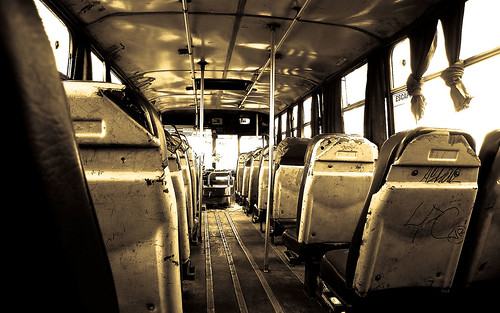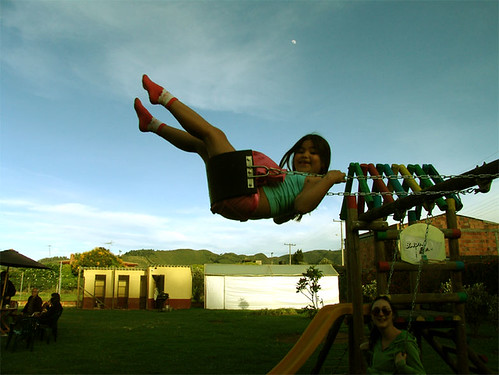the wheels on the bus

Futurarc features Jakarta's rapidly expanding and resoundingly successful Bus Rapid Transit system in this article ("Busway Moves: Jakarta’s bus rapid transit system offers hope for the rest of the city’s gridlocked transport" -by Erwin Maulana and Christen Jamar. via Erwin Maluana's blog: Rwien Universe.)
Again, multiple lessons we can learn from a sister megacity where:
Driving speeds averaging less than 15 kilometres an hour during peak times, and average commutes taking well over an hour...(the) city suffers from problems experienced in developing urban centres not only in Asia but worldwide. A combination of urban migration and growing access to cars have created a nasty snarl of traffic as Jakarta’s nearly nine million residents try to get around the city. Bring in the out-of-town commuters, estimated to swell the city’s population on a daily basis by three million people, and you’ve got the makings of an incessant and impenetrable traffic jam.
Among the many unwelcome side effects of such an unsustainable transportation network are a depressed quality of life, lower productivity and, perhaps most importantly, unhealthy air quality.
(c.f. -Peter's June 5 post "Bleah" on Metroblogging Manila -and the link to the Kate Pedroso's short article in Inquirer. -UDC)
And this analysis by Sutanto Soehodho, chairman of the Jakarta City Transportation Council (DTK-J), an urban transport stakeholder organisation. (Don't we need one of those?)
“Jakarta’s transportation conditions today are approaching crisis level,” says Sutanto Soehodho...(He) says that Jakarta’s main form of public transportation—the city bus system—is currently utilised by only two percent of the population. That is because the buses are over-crowded and uncomfortable; the other form of public transport, a light rail, provides dismal service and an inconvenient network. As a result, most people prefer the solitude and personal space of their cars, even if it means waking up earlier.
There have been regular efforts to expand the road network, but ultimately, transport experts say, energy should be directed at cutting down the number of cars. (Emphasis mine -UDC) According to Sutanto, the length of the road network increases by one percent each year, while vehicle use is climbing 11 percent annually. If they continue at that rate, he says, “Jakarta will totally collapse in traffic” by 2014.
The Jakarta Macro Transportation Scheme, Jakarta's blueprint for transportation (again, don't we need one of those?) includes:
...efforts to limit car usage, such as increasing public parking costs, congestion pricing and enforcing the 3-in-1 system (in high-traffic zones at peak hours, each car must be transporting at least three people). It also includes some road infrastructure improvements, such as widening roads and building flyovers and underpasses. The scheme’s major infrastructure projects include monorail lines and a mass rapid transit (MRT) subway. The government is also looking at the city’s waterways for transport.
..and of course, the TransJakarta Bus Rapid Transit system which...
... has turned out to be an enormous success. It currently carries 100,000 passengers a day, triple the amount it was carrying when it started. Surveys have indicated that 14 percent of Busway riders used to drive; and 80 percent of people asked said they would switch to the Busway system if it was accessible.
Its popularity has led to a rapid expansion—after the first line was launched in 2004, another two started operating in 2005, and yet another four in January of this year. By 2010 the government intends to have 15 corridors in operation, covering a total length of 159 kilometres, according to the DTK-J.
Compare that the the Metro Manila Urban Transportation Integration Project (MMUTRIP) that calls for mainly road expansion and signalization as a solution to traffic congestion. MMUTRIP will cover:
...traffic management improvements of the 3 most heavily used public transport corridors in MM. These are EDSA LRT Line 3 Corridor, LRT Line 2 Corridor and the South Luzon Expressway Corridor. It will also include the improvement of selected secondary roads to better disperse traffic over the road network and reduce congestions in arterial roads. Phase I components of the Project are:
1. On-going construction work for the 2,424 m. secondary road of Pasong Tamo. The civil works will include road, sidewalk and drainage improvements, installation of 3 new traffic signal facilities, 6 waiting sheds, 80 streetlights, 1,688 lm of pedestrian barriers including landscaping works.
2. Construction works for the improvement of EDSA Corridor through the improvement of identified secondary roads and 6 major intersecting roads. It will also involve the construction of new pedestrian bridges, rehabilitation of existing ones, elevated walkways, covered sidewalks and waiting sheds.
3. Finalization of the engineering designs for the improvement of LRT Line 2 Corridor (C.M Rector to Marcos Highway).
In MMDA's world: pedestrian barriers, yes; better bus systems, no. ("But all the important people are in cars...")
Meanwhile, Futurarc lists the sweet reasons for TransJakarta's success:
First, it is an easy and, perhaps more importantly, cheap system to get up and running quickly—the construction required is limited to building shelters and physically separating the bus lane from the rest of vehicle traffic. The shelters are clean; the buses are comfortable and more fuel-efficient. The system has been integrated into the light rail transit (LRT) coming in from the suburbs and with inter-city bus stations in Jakarta’s suburban towns. Plans are in place to integrate the system further with the monorail, subway and water-based transport systems.
And this last line, should be a daily mantra for all our traffic managers and transportation planners.
Sutanto agrees the Busway is the best way of alleviating traffic quickly in Jakarta. “One bus can carry 80 people. Sixty-five cars would be needed to carry the same number of people,” he says.Ah, but first, we have to get them out of their cars.
From Futurarc.com














